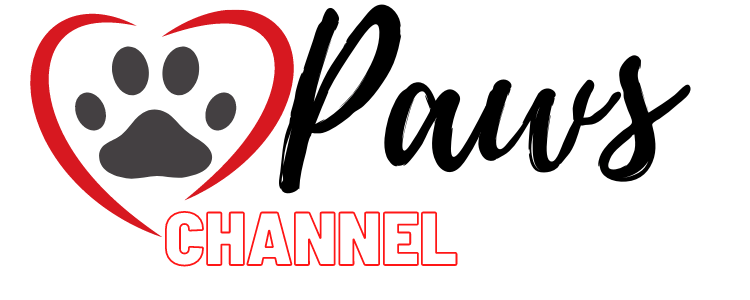WHAT IS THE CAT’S DIET ?
A BALANCED DIET
To stay healthy, cats need a balanced diet, adapted to their specific needs and given in sufficient quantities . Its intestine is rather short: about 1 meter for the small intestine and 20 to 40 centimeters for the large intestine. This anatomical peculiarity, typical of the hunter of small prey, explains why the cat must eat frequently but in small quantities (between 10 and 16 meals per day).
PROTEIN AS THE MAIN NUTRIENT
The cat is a strict carnivore : The proteins in cat food should be the main nutrient. His body cannot synthesize an amino acid, Taurine , essential for proper muscle functioning, and whose deficiencies can have dramatic repercussions on his state of health (heart failure, blindness, etc.). Taurine is found only in proteins of animal origin . The cat cannot be a vegetarian!
RESPECT FOR THE CAT’S NUTRITIONAL NEEDS
Whether industrial or household, in the form of croquettes or pâtés (or mixed), the main thing is that the cat’s diet respects its strict nutritional needs, in proteins, carbohydrates, lipids, vitamins and minerals . It will have to be adapted according to each individual by considering their age, their physiological status (sterilized or not) and their lifestyle (interior or exterior). Some cats, due to their state of health (obesity, diabetes, kidney failure …) may need a medical diet, prescribed by their veterinarian, an integral part of the treatment of their pathology. We must not, of course, forget the cat’s water needs which allow it to permanently maintain an optimal state of hydration and thus participate in its general well-being.
WHAT ARE THE NUTRITIONAL NEEDS OF THE CAT?
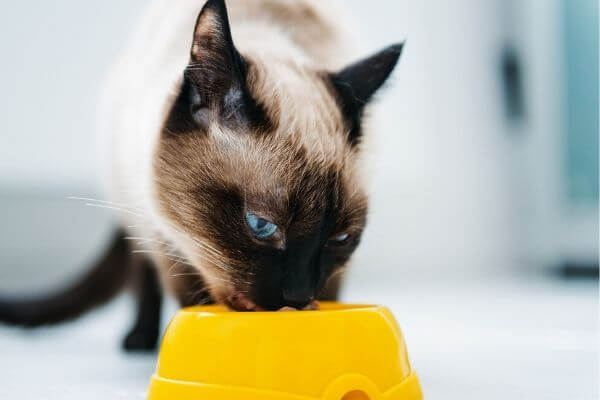
PROTEIN REQUIREMENTS
They should represent between 30 and 40% of his food intake . An adult cat weighing 5 kg needs about 26 g of protein per day. They must be of good quality and mainly of animal origin .
AMINO ACID REQUIREMENTS
The cat not knowing how to synthesize naturally taurine, essential for the proper functioning of the muscles and therefore for its survival, it must find it in its food. Taurine is found only in animal protein , so the cat is a strict carnivore.
CARBOHYDRATE AND LIPID REQUIREMENTS
Carbohydrates must not represent more than 45% of the dry matter and lipids more than 11% , under penalty of overweight, obesity or even diabetes mellitus.
VITAMIN REQUIREMENTS
Cat food must incorporate the vitamins necessary for good health, in adequate quantities (neither too little nor in excess): vitamins A, B, D, E, K and H ; It has the ability to naturally synthesize vitamin C . The cat is unable to convert carotenes in green vegetables or carrots into vitamin A. It is therefore essential to provide it in the form of animal products (liver) or in synthetic form. However, it has the ability to synthesize vitamin D in its skin (thanks to the action of solar UV rays) that it ingests by licking itself.
MINERAL SALT REQUIREMENTS
The food of the adult cat must contain mineral salts to maintain it in good health: Calcium, Phosphorus, Potassium, Copper, Zinc, Magnesium . This intake must be balanced according to his specific needs, deficiencies or excesses that can have serious consequences on his general condition.
FIBER AND ESSENTIAL FATTY ACID REQUIREMENTS
The fibers will facilitate its digestion and the essential fatty acids (omega 3 and omega 6) the beauty of its coat and its good general condition.
WATER REQUIREMENTS
It is the cat’s first nutritional need . He must find it constantly in order to guarantee him optimal hydration and to avoid concentrating his urine too much (with the risk of stone formation and kidney failure that a water deficit could cause).
PATÉE OR CROQUETTES FOR CAT, WHAT TO CHOOSE?

CAT FOOD
Dry cat food corresponds to a dry diet (humidity level below 14%). They allow the cat to eat all day long, in small quantities . The peculiarity of his short digestive tract obliges him to ingest about ten small meals a day . In addition, the kibbles help to ensure good dental hygiene by preventing the formation of tartar and by promoting blood circulation in the gums. Easy to dose, they must be of very good quality, given in adequate quantities and must meet the specific needs of each individual in order to promote their well-being.
CAT FOOD
The mash cat or cat bags are wet foods humidity can reach 70 to 80%. They allow the cat to hydrate better and prevent urinary disorders (formation of stones in the bladder) in particular. More palatable than kibble, pâtés and sachets can stimulate the food intake of fragile or convalescent cats. They have the disadvantage of not keeping too long in the open air and of being given in very large quantities if they are used alone, in order to cover the nutritional needs of the cat. For example, you have Hill’s Science Plan Feline or Royal Canin Feline Care Nutrition sachets.
MIXED FEED FOR CATS
It allows the cat to benefit from the specific advantages of kibble and pâtés. It is commonly recommended to feed your cat with 2/3 of kibble and 1/3 of pâtés (boxes and fresh sachets), the main one being the balance of the food ration , adapted according to the needs of each one (age, weight, sterilized or not, physical activity, coat, etc.).
IS HOME FOOD PREFERABLE?
The domestic food , made with fresh products must be perfectly balanced and meet the specific nutritional needs of cats. It is therefore difficult to balance and must be supplemented with minerals and vitamins that the cat cannot synthesize from natural foods. The quantity and composition of the food ration should be established and supervised by a veterinary nutritionist . In addition, it should be presented to the cat about ten times a day, the specificity of its digestive tract running by making it a “nibbler”.
HOW TO READ THE LABEL FOR CAT CROQUETTES?
Deciphering the labels on the bags of cat food is really not an easy thing, they are so complex and not always very clear! Certain information, subject to regulations, is compulsory .
THE LIST OF RAW MATERIALS
This list of raw materials used in the making of kibble for cats is essential. They will be named in their order of importance. It is always necessary to check that the quantity of nutrients correspond to their dehydrated form (indeed, 40% of meat before cooking would only represent about 20% of the ration!).
THE COMPOSITION OF THE CROQUETTES
The composition of kibble for cats must appear on the label with a regulatory obligation for the level of crude protein, fat, crude fiber, crude ash as well as additives (vitamins A, D3, E…) . The actual amount of the first ingredients on the list is essential to determine: protein should always be the primary constituent of kibble . Unfortunately, poor quality industrial kibbles contain far too many (inexpensive) cereals , thereby promoting overweight or obesity and can lead to serious pathologies such as diabetes mellitus. The regulations do not oblige to indicate the rate of carbohydrates, which is in our opinion, a very damaging deficiency in the search for a quality kibble.
QUALITY NUTRIENTS
The nutrients that make up the kibble for cats must be of high quality. Attention to the heading “meat and animal by-products” , the meat can represent only a very small percentage. The quality of meat , whose biological value is high (biological value VB corresponds to the efficiency with which the cat’s body will absorb proteins ), are much more expensive than the by-products, which explains the cost quality kibble compared to low-end ones.
CAN WE GIVE MY CAT SCRAPS?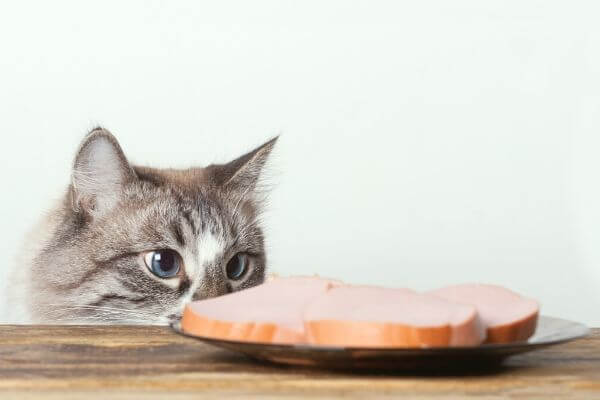
It can be tempting to feed your cat table scraps. However, we do not recommend it because it could favor his temperament of “thief” and thus give him the habit of serving himself as soon as the opportunity is given to him. If, despite everything you have to “crack”, prefer small pieces of meat or fish, the cat being a strict carnivore . Avoid fats, sugars and very salty foods (such as canned tuna not rinsed), or spicy which could cause, when given regularly, overweight (even obesity or diabetes), digestive problems (diarrhea, flatulence …) or skin. In addition, consider reducing the food intake of your feline if you give it table scraps so as not to unbalance it.
WHAT FOODS ARE DANGEROUS FOR CATS?
- The dairy products (milk, yogurt, cheese …) can cause digestive problems in adult cats, which often do more digests lactose once weaned.
- Bones are totally forbidden (even cooked), because small sharp shards could get stuck in the respiratory or digestive tracts.
- Never give your cat chocolate : it contains toxic caffeine and theobromine even in small doses.
- The grapes (fresh or dried) are very toxic to our cats, even in small amounts and can cause digestive disorders and severe renal impairment.
- The nuts and hazelnuts and other nuts are not recommended because they favor the appearance of digestive disorders in cats.
- It is also absolutely necessary to avoid giving them garlic, onion and leek, which can cause, in addition to digestive problems, anemia by destruction of red blood cells, sometimes fatal.
- The lemon and vinegar can cause stomach pain and vomiting.
- Very salty foods can, when given in excess, promote high blood pressure and kidney failure.
- Avocado can cause stomach problems and even pancreatitis.
- Raw fish contains an enzyme that causes vitamin B deficiency in the cat’s body. So avoid tartare, sushi or any other dish that contains raw fish.
- The raw potatoes and green tomatoes are toxic to cats, because of a toxic substance called solanine, destroyed by cooking and when the tomatoes are ripe.
- Needless to say that, of course, alcohol is strictly prohibited !
WHAT QUANTITY OF CROQUETTES SHOULD I GIVE TO YOUR CAT?
The amount of kibble to feed your cat daily must take into account its energy needs and the caloric value of a kibble. It is estimated that the daily requirement of a sterilized cat weighing 5 kg is about 55 kilocalories per kg, or 275 kcal per day. The average ration of kibble per day for an adult cat is between 50 and 80 grams (to be re-specified according to the brand and the specificity of each individual).
HOW MUCH PATÉE SHOULD I GIVE TO YOUR CAT?
On average, a cat eats between 200 and 300 grams of mash per day (wet food), plus 50 to 80 g of dry food. Obviously everything will depend on your cat, its own metabolism, its physical activity and the energy intake of the foods offered. An adult cat must be weighed very regularly in order to adapt the amount of food and avoid overweight.
WHEN SHOULD MY CAT EAT?
The cat is a “nibbler” who can ingest 10 to 20 meals a day ! Therefore, he will eat little food but very often . This is a natural behavior for him, perfectly suited to his relatively short digestive tract. By limiting the number of meals to 2 or 3 as in the dog, a feeling of lack can occur and generate eating and sometimes behavioral disorders (tiger syndrome characterized by the violent and sudden appearance of aggressiveness – scratches, bites, growling – following a food frustration and the feeling of hunger).
O Ù PLACE FOOD FOR CAT?
- In a quiet place : in which he feels safe, far from places of passage. Avoid disturbing your feline during his meals (no petting or too much noise).
- Away from its litter box and its sleeping place : In nature, cats make sure to meet their needs at a distance from their prey. The cat separates its territory into 3 different zones, sleep, food and elimination.
- In height when possible : It will thus be in a strategic, safe and therefore reassuring location, out of reach of any enemies!
- Separate the water and food bowls : in nature, cats devour their prey far from their water source so as not to contaminate the latter.
HOW TO FEED AN INDOOR CAT? 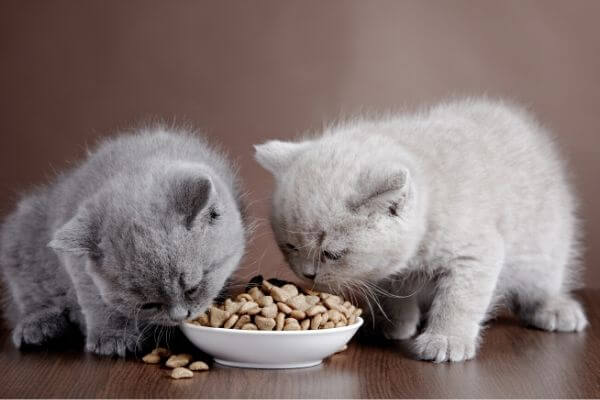
The diet of an indoor cat should not be too caloric and supplemented with fiber to improve digestion (and eliminate hairballs ingested during licking). This lack of exercise can promote obesity. In addition, it is estimated that a sedentary lifestyle associated with significant weight gain promotes the formation of urinary stones. You must therefore be extremely vigilant and choose a diet specific to indoor cats in order to promote their well-being.
HOW TO FEED MY OLDER CAT?
It is essential to adapt the diet of an 8-10 year old cat in order to preserve its health. Its physical activity is less important, it is estimated that its energy needs decrease by about 20% compared to those of an adult cat. With age, the proteins present in his food must be of very good quality and in the right quantity , so as not to “exhaust” his kidneys, which weaken over the years. It is necessary to limit the phosphorus intake , to provide vitamins in larger quantities in order to help the immune system. It is therefore very important to give your old cat quality food, in sufficient quantity but not in excess.
HOW TO FEED YOUR STERILIZED CAT?
The sterilization of a cat or a cat changes its metabolism and its food needs. Indeed, it is estimated that sterilization promotes the tendency to overweight and predisposition to kidney stones (urolithiasis). The diet of a sterilized cat must include a reduced fat content, very good quality proteins, a sufficient fiber rate to ensure its digestive transit and a good balance between vitamins and mineral salts. There are foods specially designed for sterilized cats, which must be of very good quality (protein of high nutritional value and limited energy intake) and given in adequate quantities (it is very important to monitor any possible weight gain by weighing your sterilized cat regularly, if possible every month).
HOW MUCH WATER PER DAY FOR A CAT?
Cats need fresh water every day . The amount of water necessary for proper hydration and its needs will of course depend on the size of your cat and the time of year, but also on its food. The croquettes contain on average 10% water and 80% for the pâtés. It is estimated that a 5 kg cat should drink around 250ml of water per day . Kittens and senior cats drink more water than adults. You should be concerned if you notice that your cat is drinking too little or too much : this may be a sign of an underlying condition (polyuro syndrome – polydipsia characteristic of kidney failure). Always keep fresh, clean water available.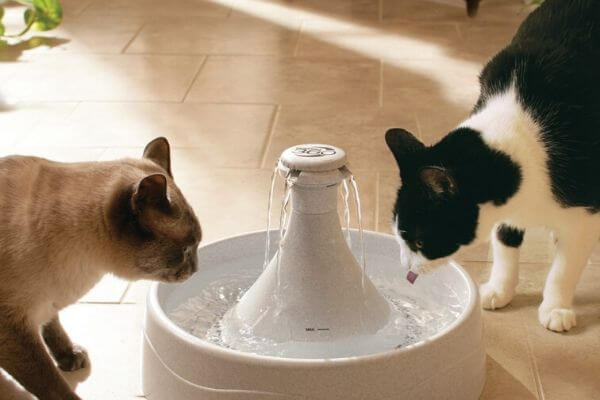
WHY CATS DON’T DRINK?
Misconception! The cat has specific water needs, of the order of 50 ml per kilo and per day in order to ensure a good state of hydration and to meet its needs. If we have the impression that our cat is not drinking enough, we can stimulate him through food (by offering him a mixed diet consisting of kibble and pâtés, the latter consisting of more than 80% water. ). And by behavior (by preferring glass or porcelain bowls to avoid the possible smell of “plastic”, by changing the water every day , and by moving the water bowl away from that containing the food). Cats love ‘playful water », That is to say that flowing from taps, flower pots, rain in puddles….
CAN I GIVE MY CAT’S MILK?
Unlike the kitten fed with its mother’s milk from birth, the adult cat is content with water to meet its water needs . Adult cats often lose the digestive capacity to digest the casein present in milk and may therefore be allergic or intolerant to milk proteins . Several symptoms can be triggered following the ingestion of milk by an adult cat, digestive disorders and diarrhea, redness and itching, etc. The cat can also be intolerant to lactose (“sugar” in milk) following the disappearance of the secretion of lactase, an enzyme allowing its digestion. Some cats retain the ability to digest lactose throughout their life , in spite of everything in limited quantities (in this case do not exceed more than 10 ml of cow’s milk per kg and per day , whether skimmed or whole).
